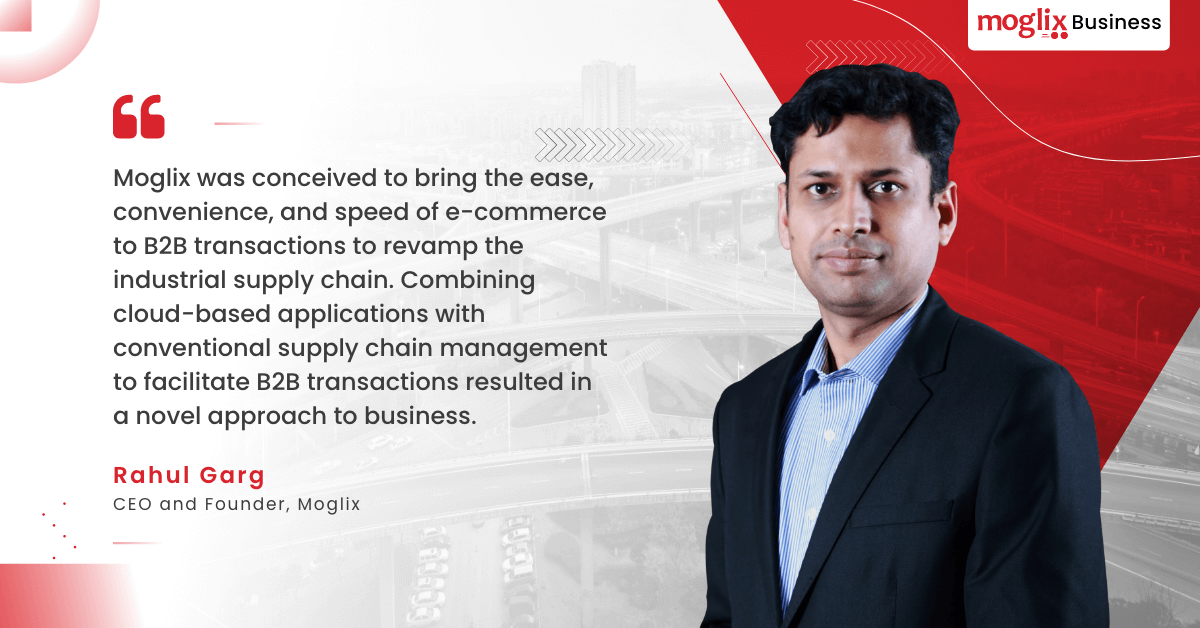The Convergence of AI/ML and Manufacturing Industry 4.0: A New Era of Innovation

The Convergence of AI/ML and Manufacturing Industry 4.0: A New Era of Innovation
Manufacturing 4.0 is the dawn of machines that can think, learn and make decisions on their own. The idea isn’t strange to us because we’ve seen similar machines in movies. We have seen the T-800 in Terminator 2 and the NARS and CASE machines in Interstellar. These machines reflected human emotions, including the need for authority and even humour. These machines filled us with a mix of delight, thrill and curiosity.
What new could be possible with this generation of machines? Fast forward to 2023 and the real world. The machines of the future are here!
Transforming Manufacturing Supply Chain: A Conversation with Rahul Garg

Transforming Manufacturing Supply Chain: A Conversation with Rahul Garg
Rahul Garg founded Moglix in 2015 with the idea of transforming industrial distribution with a technology first approach. Rahul adds Moglix was conceived to bring the ease, convenience, and speed of e-commerce to B2B transactions to revamp the industrial supply chain and utilize technology to reimagine the B2B commerce and supply chain landscape.
Unveiling the Truth Behind Talent Market Chaos: Exclusive Interview with Saumya Khare

Unveiling the Truth Behind Talent Market Chaos: Exclusive Interview with Saumya Khare
In an exclusive interview with HR.com, Saumya Khare, Senior Director of Human Capital at Moglix, discusses the significant challenges of talent management in the future and how employers can pave the way for better talent retention.
She emphasizes that the talent market is constantly evolving, and HR teams must remain vigilant. Additionally, Saumya provides insights into the challenges that talent management will encounter in the future.
Moglix: Driving Innovative Transformations and Efficiency in the Energy Sector

Moglix: Driving Innovative Transformations and Efficiency in the Energy Sector
In an exclusive interview with e-Gov magazine, Mukund Vasudevan, MD of Moglix, shared insights on how Moglix has been helping the energy sector.
He highlighted that Moglix has been enabling companies to enhance the efficiency of their supply chain management, providing inventory to minimize lead time, and making various suppliers easily accessible. Furthermore, Mukund discussed how Moglix has been supplying MRO and parts such as cables, batteries, inverters, solar panel frames, and large wind turbines.
Risk Diversification and Predictive Analytics: The Future of Pharma Supply Chain Optimization

Risk Diversification and Predictive Analytics: The Future of Pharma Supply Chain Optimization
As of 2021, 27 per cent of drug shortages in the US are due to supply chain issues. As pharmaceutical supply chains reel under the expectations and pressure of the pandemic, drug shortages have skyrocketed over the past couple of years.
The pharma supply chain is quite complex with several stakeholders including manufacturers, wholesale distributors, and PBMs. Considering multiple bottlenecks like logistics, regulations, and distribution now is the time to redesign pharmaceutical supply chains.
From Concrete to Connectivity: The Role of Urban Intelligence in India`s City Growth

From Concrete to Connectivity: The Role of Urban Intelligence in India`s City Growth
Home to around 31 per cent of its current population, India’s cities are the lifeline of the country’s infrastructure, financial ecosystem, logistical movements, and even healthcare and education. They currently contribute to around 63 per cent of the national gross domestic product (GDP), and this number is only expected to increase phenomenally in the coming years.
The Indian government expects about 40 per cent of India’s population to settle in urban areas by 2030 and pegs the urban GDP contribution at around 75 per cent by this year.
Women in Manufacturing: The Key to Unlocking Operational Efficiency

Women in Manufacturing: The Key to Unlocking Operational Efficiency
According to a GE report released in November 2021, women only accounted for 12% of India’s 27.3 million strong manufacturing sector. While this number may seem dispiriting, consider that the percentage has actually been inching northwards from 8% in 2019.
The gender gap in manufacturing
To effectively address the barrier preventing women from entering the manufacturing industry, we will need to acknowledge the magnitude of the problem at hand.
Why SMEs are Turning to MSPs for Data Protection and Cybersecurity?

Why SMEs are Turning to MSPs for Data Protection and Cybersecurity?
Earlier this year, records from the ministry of micro, small and medium enterprises (MSMEs) pegged the number of businesses in this category at over 7.9 million. Given the sheer size of the SME segment, it is evident that small businesses play a crucial role in India’s race to become a $5-trillion economy. Nearly 8 million SMEs dot India’s landscape today.
That said, they have their fair share of hurdles to tackle, with cybersecurity (or the lack of it) being one of the most threatening. Around 43 per cent of cyberattacks in the country target small business startups, and most SMEs are ill-equipped to handle such cyber risks. And even more alarmingly, over half of the SMEs, that fall victim to cyberattacks close down within six months.
Returning to On-Site Work: The Benefits of Moving Away from the Remote-Work Model

Returning to On-Site Work: The Benefits of Moving Away from the Remote-Work Model
With Covid-19 pandemic radically transforming the way how we live and work, its impact on workplace dynamics is something that has been observed and experienced for a prolonged period than expected. Owing to frequent local and global restrictions for most part of last two years, most organizations adopted hybrid workplace model with remote work becoming the mainstream model. Although the transition entailed a host of challenges, adopting tech-enabled virtual interactions made it viable after a few initial setbacks.
Breaking Barriers: The Next Big Frontiers in Fashion Supply Chain for 2023 and Beyond

Breaking Barriers: The Next Big Frontiers in Fashion Supply Chain for 2023 and Beyond
Did you know that 8-10% of carbon emissions are caused by the fashion industry alone? That is more than all the international flights and marine shipping industry combined. The fashion industry is a market worth $1.5 trillion U.S. dollars and is predicted to increase to approximately 2 trillion dollars by 2026. However, despite the market size, the industry burns with several significant challenges that need immediate attention. The fashion industry has been running on traditional production models from ages.
Conventional production hubs such as India, Bangladesh, and Vietnam have long been known for their production models based on cheap labour, access to raw materials, and low-cost manufacturing.
